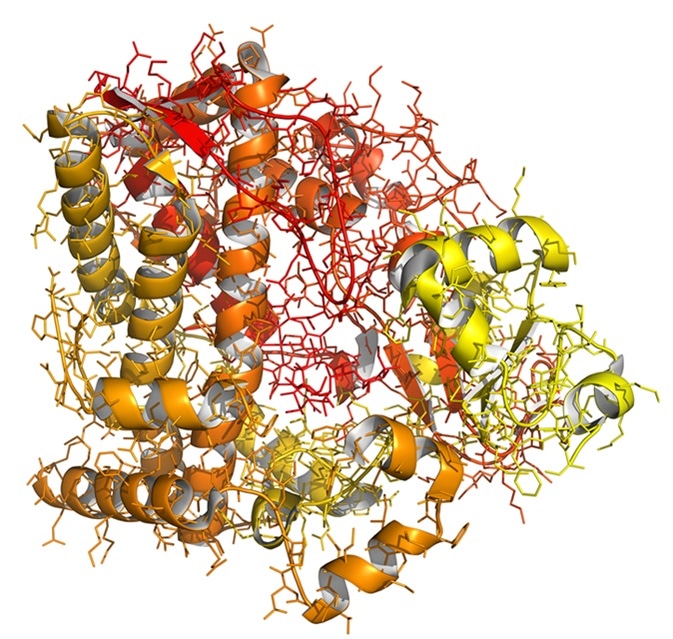The superfamily of proteins called cytochrome P450 (CYP) enzymes are involved in the synthesis and metabolism of a range of internal and external cellular components. These enzymes have been identified in many organisms, including animals, plants, bacteria, and even in a few viruses.
The name “cytochrome P450 enzymes” is derived due to their several characteristics; they are bound to the membrane of cells (cyto) and contain heme pigment (chrome and P). When bound to carbon monoxide, these proteins produce a spectrum with a wavelength at approximately 450 nm.

Cytochrome p450 liver enzyme (CYP3A4, human), chemical structure. This liver protein plays an important role in drug detoxification in the human body. Image Credit: molekuul_be / Shutterstock
How do CYP Enzymes Work?
There are seven stages of the CYP catalytic cycle.
- Firstly, the substrate binds to the CYP enzyme, inducing a conformational change and a spin state change of the heme iron.
- The second stage is initial reduction reaction of the heme group (Fe3+). NAD(P)H transfers an electron to heme via the electron transfer chain, forming Fe2+. Then, oxygen binds to the Fe2+ heme group, forming Fe2+O2. Eventually, it becomes a more stable form, Fe3+O2.
- The fourth stage is the second reduction reaction, which forms Fe3+O22-.
- The O22- then reacts with two protons, breaking the bond between the two oxygen molecules and forming (FeO)3+.
- The heme-bound oxygen atom is then transferred to the substrate.
- Finally, the product is released from the enzyme and the initial enzymatic state is returned.
Cytochrome P450
Role of CYP Enzymes in Humans
Within humans, CYP enzymes are mainly found within the endoplasmic reticulum and mitochondria of liver cells. However, they are also found in many other cells of the body. These membrane-bound proteins are involved in the metabolism of many harmful substrates, such as toxins.
Additionally, they are also important in the synthesis of many beneficial substrates, such as steroid hormones (such as estrogen and testosterone), fatty acids, and sterols (such as cholesterol and bile acids).
So far, 57 different CYP genes in 18 protein families have been identified in the human genome. Some of these enzymes have highly specific targets, such as aromatase, which only targets androgens to convert them into estrogens. However, some CYP genes have a wide range of function.
The role of CYP Enzymes in Drug Metabolism
One of the most studied roles of CYP enzymes is their function in drug metabolism. These proteins control the speed at which drugs are broken down, and the duration for which the drugs are present in the body.
An overly active CYP enzyme will render the drug ineffective. However, if these enzymes are not active enough, the drug can stay in the body for a prolonged duration leading to toxicity.
Of all the different CYP proteins that are present in the human body, six of them are involved in the metabolism of 90% of drugs. These proteins are CYP1A2, CYP2C9, CYP2D6, CYP3A4, and CYP3A5.The most important are CYP3A4 and CYP2D6.
Genetic variability within these enzymes greatly influences the rate at which drugs are broken down. Certain drugs can also inhibit or activate the enzyme or even cause harmful drug-to-drug interactions and adverse reactions. For example, around 1 in 15 individuals can have an over reactive response to beta-blockers due to genetic variation.
In addition to genetic variability, other factors can influence the function of these enzymes. For instance, diet can also on influence the activity of CYP enzymes.
Grapefruit juice contains a molecule called flavanol that has inhibitory effects on the CYP enzyme and can slow down the metabolism of drugs, leading to stronger drug effects.
Other foods that activate the CYP enzymes are charcoal-grilled foods and cruciferous vegetables (e.g. broccoli), which minimize the effect of drugs. An additional factor that affects the function of these enzymes is smoking. Smoking activates CYP1A2, leading to increased drug metabolism and lowering drug levels in the body.
CYP Enzymes and Personalized Medicine
There is extensive research being carried out using CYP enzymes in the area of personalized medicine.
An example of a gene that has been investigated as a possible target for personalized medicine is the CYP2C9 gene that is involved in the metabolism of warfarin. The protein product of this gene controls the amount of warfarin that is required by each patient. Therefore, it has been suggested that by identifying the specific gene variant that a patient possesses, informed decisions could be made with respect to dosing. This can prevent the possibility of internal bleeding, a common and potentially dangerous side effect of warfarin.
By characterizing the CYP450 enzyme of each individual, the optimal drug dosage levels can be prescribed preventing the dangers of overdose or the possibility of inefficient treatment.
Further Reading